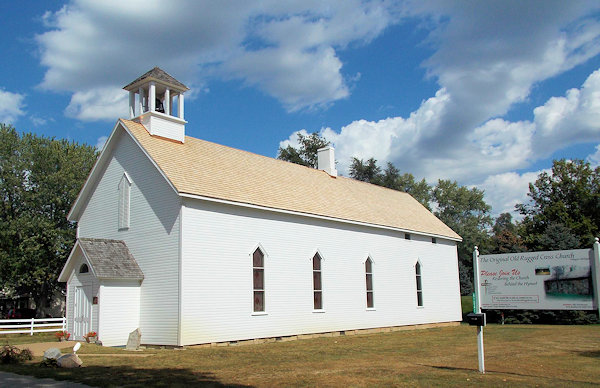The hymn, “The Old Rugged Cross,” has two Michigan connections … Albion and Pokagon.
What do the gospel hymns “The Old Rugged Cross” and “I Come to the Garden Alone” have in common? Both compositions were completed virtually at the same time (1913) by American Methodists. Each reflects on key symbols of Holy Week – the cross of Good Friday and the garden of the Resurrection. Both songs speak from a first-person perspective, composed in a ballad style (6/8 meter) with refrains. Both songs place the singer in the biblical scene, one at the foot of the cross where Jesus hung, and the other in the garden walking with the risen Christ following the Resurrection. The composers composed both the words and the music. Perhaps most of all, both George Bennard and C. Austin Miles wrote songs that many parishioners deeply love, and others love to hate.
George Bennard (1873-1958) was born in Ohio, but raised in Iowa. Converted at a Salvation Army meeting, he later became a Methodist evangelist. The composition of the song began in Albion, Michigan, late in 1912 and was finished during a revival in Sturgeon Bay, Wisconsin, where Bennard and his revival partner, Chicagoan Ed E. Mieras, premiered it as a duet on the last evening of the meeting, January 12, 1913.
The hymn in its final form was first sung by Bennard at the 1st Methodist Episcopal Church of Pokagon later in 1913.
Good Friday Services will be held at the Old Rugged Cross Church in Pokagon at 1:00 pm on April 14. Click here to learn more.
The completed song was first published in Heart and Life Songs for the Church, Sunday School, Home, and Campmeeting (1915), edited by Bennard and two other colleagues. From this point, it became a staple of Billy Sunday’s evangelistic crusades, promoted by his chief musician Homer Rodeheaver (1880-1955), who eventually bought the rights to the song.
The composer employs the poetic device of hypotyposis – painting a scene – in his text. In stanza one, he describes the cross “on a hill far away,” though one may still picture the scene as if kneeling at the foot of the cross. Stanzas two and three refer to Christ on the cross. In stanza two, Christ is called the “dear Lamb of God” (John 1:29). The reference to Jesus is more direct in stanza three. Furthermore, he adds to the hypotyposis by noting that the cross is “stained with blood.”
Another poetic technique employed effectively by the composer is that of paradox. In stanza one, though the cross is an “emblem of suffering and shame,” the singer still “loves that old cross.” In stanza two, though the cross is “despised by the world,” it still “has a wondrous attraction to me.” In stanza three, though the cross is “stained with blood,” for the singer, it still has a “wondrous beauty.”
This hymn stands in a long line of devotional poetry that venerates the cross in some way. “The Old Rugged Cross” has proven to be extremely popular as a country gospel solo recorded by numerous artists: Ernest Tubb, Andy Griffith, Jim Reeves, Johnny Cash and June Carter, Patsy Cline, Merle Haggard, Loretta Lynn, Tennessee Ernie Ford, Willie Nelson, and many more. Mahalia Jackson made a notable recording of the song on her album, Mahalia Jackson Sings the Best-Loved Hymns of Dr. Martin Luther King, Jr. (1968). It was also a staple of George Beverly Shea’s repertoire during the Billy Graham evangelistic campaigns.
A History of Hymns by Michael Hawn, Discipleship Ministries contributed to this report.
Last Updated on April 3, 2017

